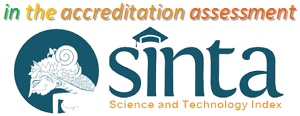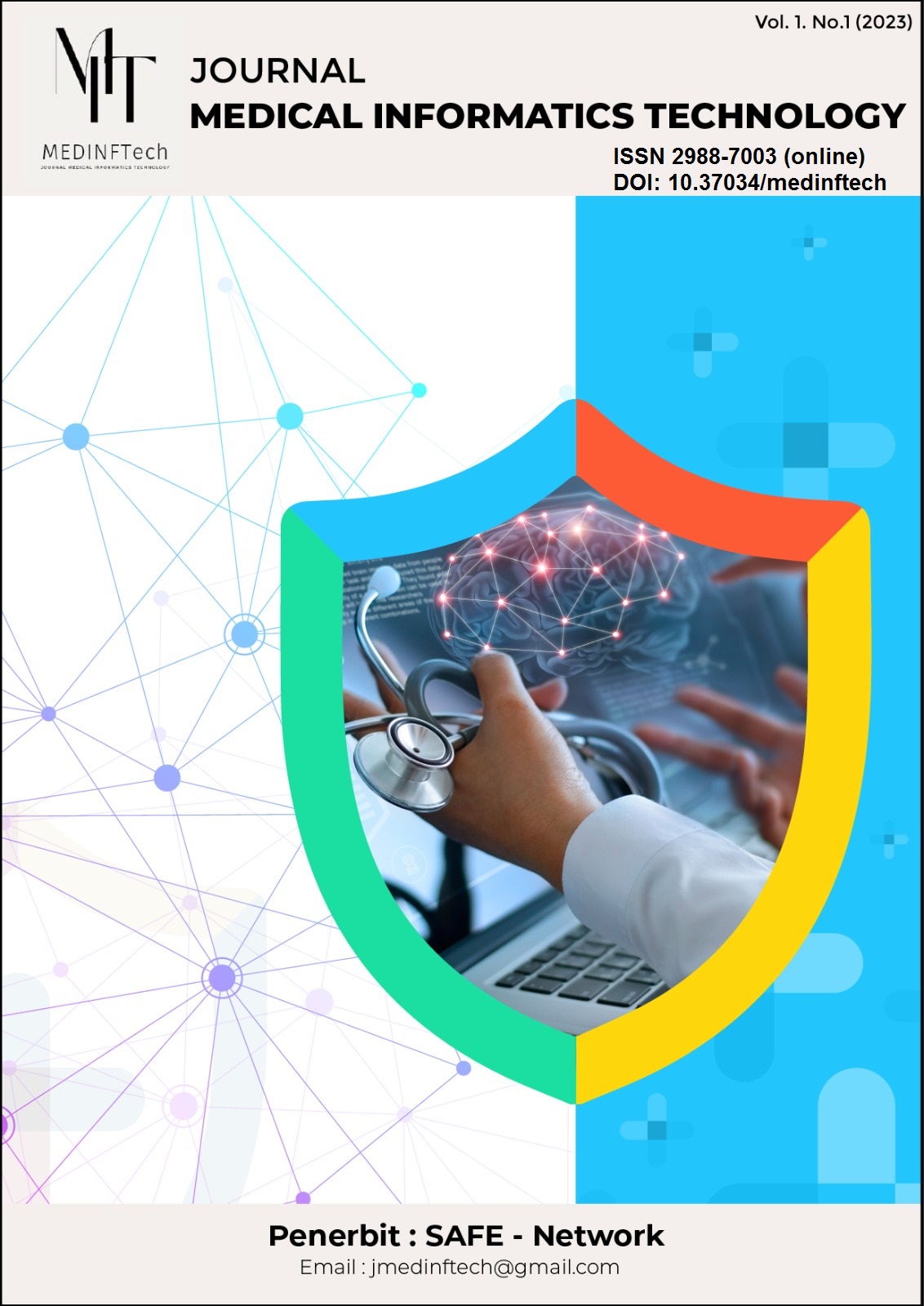Measuring User Acceptance Of ALODOKTER Application With Technology Acceptance Model To Enhance Health Service Quality
DOI:
https://doi.org/10.37034/medinftech.v3i3.47Keywords:
ALODOKTER, Healthcare Application, Perceived Usefulness, Technology Acceptance Model , User AcceptanceAbstract
ALODOKTER is one quickly evolving application in the healthcare services sector. The purpose of this application is to help medical professionals carry out their jobs more effectively by giving the community rapid and easy access to healthcare services. This study aims to measure user acceptance of the ALODOKTER application using the Technology Acceptance Model (TAM) approach to improve the use and quality of health services. A survey method with a quantitative approach was employed to analyze perceived ease of use (PEU), perceived usefulness (PU), attitude towards use (ATU), behavioral intention to use (BIU), and actual use (AU) of the application. The study involved 41 respondents from various demographic backgrounds. Results show significant relationships between user perception variables, attitudes, and actual use. Correlation analysis revealed strong relationships between PEU, PU, and ATU, with a very strong correlation between ATU and BIU. Linear regression analysis indicated that BIU was the strongest predictor of actual use of the app (β = 1.066, p < 0.01), followed by PU (β = 0.628, p < 0.01). The regression model explained 38.7% of the variance in actual use. Cronbach's Alpha coefficients for all scales exceeded 0.9, indicating high reliability of the instruments used. This research suggests that ALODOKTER developers should focus on enhancing the perceived usefulness and ease of use of the application to increase acceptance and use. The study's limitations include a small sample size and reliance on self-reporting, suggesting the need for further research with larger samples and more diverse methods.
Downloads
References
F. D. Davis, “Perceived Usefulness, Perceived Ease of Use, and User Acceptance of Information Technology,” MIS Q., vol. 13, no. 3, p. 319, Sep. 1989, doi: 10.2307/249008.
N. Galuh Puspitarani Sudaryono, M. Fadhiil, S. Syarifah, and E. Rinawati Simanjuntak, “Application of Technology Acceptance Model (TAM) in Telemedicine Application During Covid-19 Pandemic,” J. World Sci., vol. 2, no. 7, pp. 909–921, Jul. 2023, doi: 10.58344/jws.v2i7.311.
M. Haghi Kashani, M. Madanipour, M. Nikravan, P. Asghari, and E. Mahdipour, “A systematic review of IoT in healthcare: Applications, techniques, and trends,” J. Netw. Comput. Appl., vol. 192, p. 103164, Oct. 2021, doi: 10.1016/j.jnca.2021.103164.
M. Rouidi, A. Elouadi, and A. Hamdoune, “Acceptance and use of telemedicine technology by health professionals: Development of a conceptual model,” Digit. Health, vol. 8, p. 205520762210816, Jan. 2022, doi: 10.1177/20552076221081693.
A. H. H. M. Mohamed, H. Tawfik, D. Al-Jumeily, and L. Norton, “MoHTAM: A Technology Acceptance Model for Mobile Health Applications,” in 2011 Developments in E-systems Engineering, Dubai, United Arab Emirates: IEEE, Dec. 2011, pp. 13–18. doi: 10.1109/DeSE.2011.79.
A. A. AlQudah, M. Al-Emran, and K. Shaalan, “Technology Acceptance in Healthcare: A Systematic Review,” Appl. Sci., vol. 11, no. 22, p. 10537, Nov. 2021, doi: 10.3390/app112210537.
S. A. Kamal, M. Shafiq, and P. Kakria, “Investigating acceptance of telemedicine services through an extended technology acceptance model (TAM),” Technol. Soc., vol. 60, p. 101212, Feb. 2020, doi: 10.1016/j.techsoc.2019.101212.
A. M. AlBar and M. R. Hoque, “Patient Acceptance of e-Health Services in Saudi Arabia: An Integrative Perspective,” Telemed. E-Health, vol. 25, no. 9, pp. 847–852, Sep. 2019, doi: 10.1089/tmj.2018.0107.
P. Y. K. Chau and P. J.-H. Hu, “Investigating healthcare professionals’ decisions to accept telemedicine technology: an empirical test of competing theories,” Inf. Manage., vol. 39, no. 4, pp. 297–311, Jan. 2002, doi: 10.1016/S0378-7206(01)00098-2.
A.-C. L. Leonardsen, C. Hardeland, A. K. Helgesen, and V. A. Grøndahl, “Patient experiences with technology enabled care across healthcare settings- a systematic review,” BMC Health Serv. Res., vol. 20, no. 1, p. 779, Dec. 2020, doi: 10.1186/s12913-020-05633-4.
A. Alsyouf et al., “The Use of a Technology Acceptance Model (TAM) to Predict Patients’ Usage of a Personal Health Record System: The Role of Security, Privacy, and Usability,” Int. J. Environ. Res. Public. Health, vol. 20, no. 2, p. 1347, Jan. 2023, doi: 10.3390/ijerph20021347.
M. Husin et al., “Translation and Validation of the Questionnaire on Acceptance to Telemedicine from the Technology Acceptance Model (TAM) for Use in Malaysia,” BioMed Res. Int., vol. 2022, pp. 1–9, Apr. 2022, doi: 10.1155/2022/9123887.
S. C. Suwandi, N. Chandra, R. Margareta, and A. K. Sulaiman, “The Influence of Perceived Ease of Use, Perceived Usefulness, and Price Value on Behavioral Intention of Telemedicine Application Users,” Jurnal Sehat Indonesia (JUSINDO), vol. 7, no. 2, pp. 747–754, Apr. 2025, doi: 10.59141/jsi.v7i2.266.
G. Amanda and C. V. Layman, “Examining the Intention to Use Mobile Health Applications Amongst Indonesians,” Milestone: Journal of Strategic Management, vol. 2, no. 2, p. 103, Nov. 2022, doi: 10.19166/ms.v2i2.5924.
S. Alexandra, P. W. Handayani, and F. Azzahro, “Indonesian hospital telemedicine acceptance model: the influence of user behavior and technological dimensions,” Heliyon, vol. 7, no. 12, p. e08599, Dec. 2021, doi: 10.1016/j.heliyon.2021.e08599.
J. F. Hair, W. C. Black, B. J. Babin, and R. E. Anderson, Multivariate Data Analysis, 8th ed. United Kingdom: Cengage Learning, 2019, 793 pages, ISBN: 978-1-4737-5654-0.
Y. Li, R. Liu, J. Wang, and T. Zhao, “How does mHealth service quality influences adoption?,” Industrial Management & Data Systems, vol. 122, no. 3, pp. 774–795, Feb. 2022, doi: 10.1108/imds-12-2020-0758.









